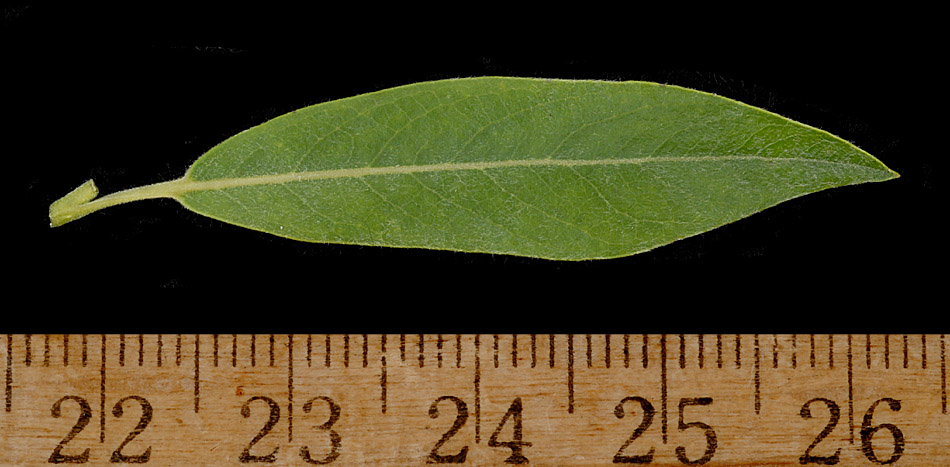 |
Petiolaris: Answers
to key questions in Conifers & Catkin-Bearing Trees and Shrubs of
Saskatchewan, Fascicle 5, Flora of Saskatchewan by Anna Leighton leading
to this species. The answers are in the order you would normally work
through the key.
 |
Catkins
usually flowering as leaves emerge, sometimes just before leaves emerge
or throughout the season, subtended by small green leaves of the
flowering branchlet that supports them. NOT [Catkins usually
flowering before leaves emerge, borne directly on bare branches
(sessile) and subtended by 1 - 3 short, greenish or brownish, caducous
bract-like leaves] |
 |
Low to
tall shrubs or trees; not confined to subarctic regions. NOT
[Dwarf shrubs <= 0.15 m (15 cm) tall; subarctic regions] |
 |
Shrubs,
usually with several stems; ovaries glabrous or hairy. NOT
[Trees, with a single trunk, or with several trunks of tree stature;
ovaries glabrous] |
 |
NOT
[Plants flowering as leaves emerge or throughout the season, often
bearing branched catkins; leaf blades linear or strap-shaped, 9 – 14
– 24 times longer than wide, up to 11 mm wide with margins remotely
spinulose-serrulate, the teeth widely spaced; hairs on leaves white,
ferruginous hairs lacking; plants forming extensive colonies by root
shoots] |
 |
Petioles
without glandular dots or lobes at distal end, or with occasional,
inconspicuous dots; floral bracts not as above, if conspicuous and pale,
then not deciduous. NOT [Petioles with glandular dots or lobes at
distal end; floral bracts pale tawny, 1.2 – 4 mm, conspicuous during
flowering, deciduous after flowering] |
 |
Ovaries
hairy. NOT [Ovaries glabrous] |
 |
Ovaries
sparsely short-silky; stipes long (1.4 – 6 mm); styles short (0 –
0.5 mm. NOT [Ovaries without the above combination of characteristics
– if appearing sparsely short-silky, then stipes shorter than 1.4 mm
or styles longer than 0.5 mm] |
 |
Stipes 1.4
- 4 mm; floral bracts 1 – 2 mm, brown, tawny, light rose or bicolor;
catkins 12 - 39 mm, stout to globose; flowering branchlets 1 – 11 mm;
leaf blades strap-shaped to very narrowly elliptic, 5 – 7 – 9 times
longer than wide; leaf blade veins flat on lower surface; ferruginous
hairs may be present on leaf blades and ovaries; NOT [Stipes 2 – 6 mm;
floral bracts 1 – 3 mm, tawny; catkins 16 – 80 mm, stout, slender or
subglobose; flowering branchlets 1 – 26 mm; leaf blades narrowly
oblong, narrowly elliptic, elliptic, oblanceolate or obovate, 2 – 3
– 4 times longer than wide; leaf blade veins protruding on lower
surface; ferruginous hairs absent on leaf blades and ovaries.]
|
|
 |
Salix: Answers
to key questions in Conifers & Catkin-Bearing Trees and Shrubs of
Saskatchewan, Fascicle 5, Flora of Saskatchewan by Anna Leighton leading
to this genus.
 |
shrubs or trees; NOT [trees] |
 |
buds covered by 1 scale; NOT [buds
covered by 3-10 scales] |
 |
buds scale not resinous; NOT [bud scale
usually resinous] |
 |
catkins sessile or terminating flowering
branchlets; NOT [catkins sessile] |
 |
catkins erect, spreading, or +/-
pendulous; NOT [catkins pendulous] |
 |
floral bracts entire, erose, bifid, or
irregularly toothed; NOT [floral bracts deeply cut] |
 |
perianth reduced to an adaxial nectary
(rarely also an abaxial nectary, then the 2 nectaries distinct or
connate into a shallow cup); NOT [perianth reduced to a
non-nectariferous, cup-shaped or shallow saucer-shaped floral disc] |
 |
stamens 1, 2, or 3 – 10; NOT [stamens 6
– 60 (70)] |
 |
capsules obclavate to ovoid or ellipsoid;
NOT [capsules narrowly ovoid to spherical, with the floral disc
persistent at base] |
 |
capsules 2-valved; NOT [capsules 2 - 4
valved] |
|

